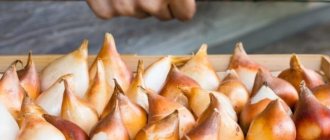Historical reference
Okra has been around the world since ancient times. Its other names are okra, gombo, abelmosh, edible hibiscus and lady's fingers. Okra has become widespread in Europe, Asia and Africa. Anton Pavlovich Chekhov himself planted okra on his plot, and it is believed that it was he who called it “lady fingers”.
The beauties of ancient Egypt and China often included okra fruits in their diet, knowing that it helps to prolong youth and preserve beauty. But the plant gained particular popularity during the Second World War. Okra seeds were dried, fried and ground. The resulting powder successfully replaced coffee for Asians and Africans in difficult times. Since then, okra can be found in the markets of these countries at any time.
Botanical description
Okra is an annual herbaceous plant with a taproot, slightly curling. The stem of the plant is thickened, slightly branched, from 40 cm to 2.5 m in height. The stems are pubescent with thin bristles, contact with which can cause irritation to the skin of the hands.
The leaves are solitary, of various shapes, which depend on their placement on the stem. The lower leaves are entire, the middle leaves are five-fingered, and the upper leaves are strongly dissected.
The flowers are large in size, on short pubescent pedicels, pale yellow in color with a crimson spot in the middle.
In appearance, okra fruits resemble small long peppers, which have five sides on the outside; if you cut the fruit crosswise, the cut will be in the shape of a five-pointed star. The inside of the pod is densely filled with small and soft edible seeds, wrapped in mucus. Okra tastes similar to green beans or zucchini.
The fruits ripen in multi-cavity capsules, which burst when ripe, and round brownish seeds spill out of them.
Classification and varieties
Okra belongs to the annual herbaceous plant of the Abelmosh genus of the Malvaceae family. This vegetable has several of the most popular varieties that can be cultivated in the vastness of Russia:
- Juno. A tall and productive variety with enlarged pods about 10-25 cm long.
- Bombay. A low-growing variety of medium ripening with small pods about 9 cm long.
- Vlada. A high-yielding variety of medium ripening with enlarged pods 18-20 cm long.
- Lady fingers. A low, mid-season variety with medium pods about 6-20 cm long.
- White velvet, green velvet. A low-growing variety with abundant fruiting.
- Red velvet. A distinctive feature of this variety is the red color of the fruits and late ripening.
- Star of David. A tall variety with small pods up to 8 cm long.
Pharmacological properties
Due to its valuable composition, okra has the following health properties:
- Increasing immunity, restoring strength after serious illnesses, stress and operations.
- Increases blood circulation, strengthens the walls of blood vessels, stabilizes pressure.
- Improving the functioning of the gastrointestinal tract.
- With low caloric intake, a feeling of satiety occurs, which leads to weight loss.
- Sugar levels decrease in diabetic patients.
- Glutathione reduces the risk of cancer.
- Folic acid is very useful during pregnancy for the normal development of the fetus.
Benefits of okra
The benefits of okra for the gastrointestinal tract
The mucus contained in okra in significant quantities has a beneficial effect on the digestive system:
- Enveloping the mucous membranes leads to gradual healing of ulcers and erosions.
- The cells of the mucous membranes are stimulated to gradually improve.
- The production of digestive juices is normalized.
- Antiseptic and bactericidal effects.
- Waste and toxins are absorbed and eliminated from the body.
- Eating fresh okra prevents the absorption of bad cholesterol.
- Moisturizing mucous membranes and softening stool, preventing constipation and cracks.
In addition, glutathione, found in okra, protects liver cells from the harmful effects of alcohol, nicotine and medications.
Benefits of okra for the respiratory system
Okra contains a balanced set of vitamins and nutrients, which helps in the treatment of respiratory diseases:
- Inflammatory processes are relieved.
- Pathogenic microflora is suppressed.
- The mucous membranes are moisturized.
- Sensitization of the upper respiratory tract is reduced.
- Eating fresh okra prevents swelling of the mucous membranes.
The benefits of okra for the circulatory system and metabolism
Constant consumption of this vegetable helps improve blood composition, improve the functioning of the heart and blood vessels:
- Blood circulation in the capillaries is normalized.
- The hemoglobin content in the blood increases.
- The formation of atherosclerotic plaques is reduced.
- The permeability of vascular walls decreases and their elasticity increases.
- Blood sugar levels decrease and carbohydrate metabolism is normalized.
- General metabolism improves.
Benefits of okra during pregnancy
It is especially beneficial for women to consume okra fruits during early pregnancy. The high folic acid content in okra promotes the proper development of the fetal neural tube. This prevents the occurrence of all kinds of anomalies during the formation of the brain and spinal cord.
Use in cooking
Okra can be used in cooking, and it can be cooked in completely different ways, for example, it can be salted, pickled, fried, stewed, steamed and deep-fried. In addition, the fruits can be consumed raw.
Please note that okra fruits are covered with hairs. To avoid irritation, cooking okra begins by cleaning the fruit from these same hairs. Another important point: when stewing or boiling, okra releases a lot of mucus. If you want to get rid of it, you should cook okra in boiling oil. In this case, it will resemble fried butter.
However, the mucus contains some of the beneficial properties of okra. In particular, it helps with inflammation of the duodenum and stomach ulcers, and also improves digestion. Other valuable properties of okra are its ability to lower blood sugar levels, dilute blood clots and strengthen the walls of blood vessels.
The calorie content of okra is only 31 kcal per 100 g. At the same time, it is rich in vitamins, microelements and fiber. So, okra is an ideal product for weight loss. In addition, it normalizes metabolism and removes toxins from the body. It is not surprising that okra is widely used in cooking. It can be boiled, stewed, fried, added to soups, salads, meat and vegetable stews. Okra goes equally well with meat, fish and poultry. And its seeds, after careful drying and roasting, can be used to make coffee.
This vegetable can easily replace zucchini in ratatouille and stews.
Okra can be used to prepare a variety of side dishes, and can also be added to salads and soups. These fruits go well with Provençal oil and various spices, which improves the taste of a dish made from an exotic vegetable.
Okra can be dried and frozen so that the fruit can be used year-round.
In addition to the pods, young leaves can also be used for food. They are added to salads and soups. The seeds are also edible. They are roasted and used to make a bitter-tasting drink that is somewhat similar to coffee. In addition, oil with a specific taste and smell is made from okra seeds. Also, young seeds of this vegetable can replace green peas.
Use in folk medicine
Okra in folk medicine is used to treat various diseases of the respiratory system, digestion, heart and blood vessels:
- For atherosclerosis, it is recommended to eat about 200 grams of raw okra fruits per week.
- For colds and severe coughs, prepare the following infusion: take 2 tbsp. l. ground okra roots and pour 3 cups of slightly warm boiled water. Let it brew for about an hour, then add a little honey and drink 1 tbsp. l. 8 times a day until complete healing.
In addition, eating this vegetable fresh has a beneficial effect on diabetes, digestive problems and constipation. Okra is also useful for enhancing male potency.
Okra in cooking
Having learned what okra is, let’s determine how it is eaten. The vegetable can be prepared using any available methods, but just do not subject it to heat treatment for too long. Before eating, it is necessary to remove the fine hairs from okra, otherwise the food will have a bitter taste. To do this, you need to pour boiling water over the okra, then remove the peel along with the fibers. Let's look at several recipes for preparing this exotic vegetable.
Vegetable stew with okra
The dish turns out incredibly tasty, and also very healthy. The recipe will appeal to supporters of a healthy diet.
Ingredients:
- frozen okra – 800 g;
- tomato paste – 3 tbsp;
- tomatoes – 2 pcs.;
- olive oil – 50 ml;
- onion – 2 heads;
- garlic – 3 cloves;
- salt, spices.
Sequencing:
- Thaw okra at room temperature.
- Cut the tomatoes, onions and garlic cloves into small pieces.
- Pour oil into the pan and first add the onion and garlic.
- Meanwhile, dilute the tomato paste with a glass of water.
- Add tomatoes to the pan and simmer for a few minutes.
- When the tomatoes give juice, add the okra, after 5 minutes pour in the tomato juice, add spices and mix.
- Simmer for 15 minutes with the lid closed.
You can cook rice as a side dish for the stew.
More goodies: Polish-style bigos - very tasty Classic Polish-style bigos - a very famous and popular dish. And this is not surprising - after all, bigos and...
Okra in Arabic
This recipe was once brought from the East and was loved in our country. After all, they have long known what okra is, and even more so, how they eat it.
Ingredients:
- okra – 400 g;
- beef – 300 g;
- onion – 1 head;
- garlic – 3 cloves;
- tomatoes – 4 pcs.;
- tomato paste – 2 tbsp;
- water – 600 ml;
- vegetable oil – 50 ml;
- salt, spices.
Sequencing:
- Cut the meat into medium-sized pieces and fry it in sunflower oil, then add chopped onion and garlic.
- Pour in the water, and when it boils, add the okra, previously defrosted at room temperature.
- At the end, add tomato paste, spices and simmer a little more with the lid closed.
In the East, this dish is served with rice, fresh hot pepper and lemon.
Advice!
You should not simmer okra for more than 20-25 minutes, otherwise it may turn into sourdough.
Use in cosmetology
Eating okra pods helps improve the appearance of hair, nails and skin. These properties of okra were familiar to the beauties of Cleopatra's time. They included this vegetable in their daily diet.
Today, cosmetology uses the pulp of okra fruits, which is added to various formulations to improve the condition of skin and hair:
- Balm for hair shine. Young chopped okra pods are boiled for about 30 minutes. Cool and filter the broth, add a couple of drops of lemon juice to it. Apply the resulting balm to well-washed hair. This gives a special shine to the hair.
- Cream with okra. To reduce inflammation and acne on the face, use squeezed okra juice (okra extract), which is added to your regular daily cream.
Use in cooking
Edible hibiscus is most often included in the diet of residents of Asia and Africa; it is eaten less often in Western Europe and America.
In Russia, this vegetable is still undervalued, but in vain. Its pods have a delicate, subtle flavor, which is enhanced by heat treatment. Okra can be boiled, stewed, fried, canned and blanched. It goes well with meat, fish, mushrooms, vegetables, rice, a variety of herbs and spices, and sauces.
In soups, okra releases too much mucus. Such soups are recommended for the treatment of diseases of the digestive organs. If you need to reduce the concentration of mucus in the soup, this can be adjusted by adding vinegar, lemon juice or tomato paste.
Roasted okra seeds are ground to produce a coffee-flavored powder. That’s what they call it – “Gombo” coffee. Moreover, this coffee does not contain caffeine; it can even be given to children.
Origin story
The ancient Egyptians grew okra on the banks of the Nile more than 3,000 years ago. In Sudan it has been known in culture for about 6,000 years. It is interesting that the plant had a very wide use: not only the fruits, but also okra leaves were eaten, and burlap and rope were made from its fibers. Today this culture is very popular in many countries of Asia, Africa, Southern Europe and America.
And although the plant’s homeland is supposedly North and West Africa, okra also grows successfully in harsher climates if it is cultivated from seedlings. Russian writer A.P. Chekhov grew and harvested okra in his Melikhovo estate near Moscow back in the 19th century.
The growing season of this vegetable crop is quite long, so the use of the seed method for cultivating okra in open ground is practiced only in the southern regions. In general, the agrotechnical principles for growing okra in temperate climates are similar to the technology for growing eggplants.
Application in horticulture
Many gardeners like to grow rare plant species in their gardens. One of these plants is okra. There are small okra plantations in the Krasnodar and Stavropol territories, as well as in the Caucasus. In other southern regions, okra is grown by amateur gardeners.
Seedling method of growing okra
Seeds are sown for seedlings in the last days of April or in the beginning of May according to the following scheme:
- Okra seeds take a long time to germinate, so to speed up the process, they are placed on a moistened napkin and left for a day in a warm place.
- It is convenient to sow seeds in peat pots. They are placed on a pallet and filled with soil mixture. One seed is pressed into each pot to a depth of 4 cm.
- Water the plantings with slightly warm water, then cover with film. Maintain an ambient temperature of approximately +20 degrees.
- When the seedlings sprout, the film is removed and the seedlings are moved to a more illuminated place.
- Next, water the seedlings as needed and feed them with minerals every 14 days.
- After about 35-45 days, the grown seedlings are transplanted into a permanent place in the garden.
A non-seedling method for growing okra
In southern regions with a long summer period, a seedless method of growing okra is used. In the spring, when the soil warms to a temperature of +16 degrees, the seeds are sown. The seeds are pre-soaked, then they are deepened into the moistened soil by 3-4 cm. The distance between the seeds should be about 60 cm, and between the rows - 40 cm.
Planting okra
The place for planting okra is chosen to be well-lit, warm and dry, without drafts. The soil must be fertile. The beds are prepared in the fall - they add minerals and organic matter and dig them well. If the variety is tall, then the distance between plants is maintained at about 90 cm, and between rows - 50 cm. The planted plants are watered and mulched with peat and humus.
Care
- Watering. At the beginning of the growing season, the plant needs more frequent watering, then the okra is watered as the soil dries out.
- Feeding. Phosphorus-potassium and organic fertilizers are alternated once every 2 weeks.
- Bush formation. Some gardeners recommend removing side shoots; they still do not bring much benefit. Other gardeners believe that it is necessary to pinch the top of the shoot to obtain a bountiful harvest.
- Disease and pest control. Okra is often plagued by blackleg, rust and powdery mildew. To prevent these diseases, when preparing the beds, you need to spill them with phytosporin. Of the harmful insects, okra can be attacked by aphids, thrips and cabbage cutworms. Plants must be periodically inspected and, if pests are detected, treated with insecticides.
Pests and diseases of okra
Like most vegetable plants, okra can suffer from diseases and pests. Powdery mildew can cause great harm. It appears as a thick white coating on both sides of the leaf and on other parts of the plant. The causative agent of the disease overwinters on plant debris. To avoid its spread, plant debris is promptly removed and the weeds around the greenhouse that are the first to be affected by powdery mildew and are carriers of the disease are systematically removed: plantain, comfrey, sow thistle.
Brown spot affects the plant at high humidity in greenhouses and greenhouses. Yellowish spots appear on the upper side of the plant leaves, and on the lower side there is a coating of first light, then dark brown color. With severe damage, the leaves turn brown and dry out. The causative agent of the disease overwinters on plant debris.
Thrips is a small insect that parasitizes mainly in greenhouses. Due to their fertility, thrips can damage a large number of plants in a short period of time. Whitish-yellow spots appear on the leaves from their pricks; when severely damaged, the leaves turn brown and dry out.
When thrips appear, infusions and decoctions of insecticidal plants of hot pepper (50 g/l), wormwood (100 g/l) are used, as a more exotic option - orange, tangerine, lemon peels (100 g/l). For better adhesion, before spraying, add 20-40 g of laundry soap per 10 liters to the solution.
The cabbage cutworm, whose caterpillars appear by the middle or end of May, is distinguished by its extraordinary gluttony. They eat almost all the leaves, leaving only the veins. If the number is small, caterpillars are collected manually, and if the number is very large, they are sprayed with biological preparations: bitoxybacillin or lepidocide (40-50 g per 10 liters of water).
In wet years, okra can be affected by slugs, which they fight in traditional and all possible ways: remove weeds, carefully loosen the soil, set traps under which slugs hide, sprinkle the rows with ash, lime or superphosphate, and also place beer in trays for which they they slide together.
How to select and store okra
Okra is slowly starting to appear in large supermarkets and on market stalls. You need to know how to choose good pods. They should be small in size, up to 10 cm, bright green in color, without yellow or brown spots, with elastic skin and delicate bristles. There is a rare variety of okra - Red Velvet, whose skin has a red tint. If the pod is glossy and without hairs, then the vegetable will be overripe, fibrous, and not suitable for food.
You can store okra in the vegetable compartment of the refrigerator, but no more than 3 days. The harvested crop can be frozen, dried or preserved. Salted and pickled okra is very tasty.
How to grow?
Fortunately for many gardeners who decide to grow this plant, Okra is unpretentious in its cultivation and care.
Reproduction methods
There is only one way to propagate this crop - collecting seeds, which are later simply sown directly on the ground itself or grown first as seedlings. And then, together with the soil, they are transplanted into a greenhouse.
Do not tear up the roots of the plant under any circumstances, as such okra may not survive and there is a high probability that it will die.
Landing
As mentioned above, okra can be grown in 2 ways:
- Sowing in pre-prepared holes on a plot of land.
- Planting seedlings with further transfer of the plant along with the roots to the greenhouse for further cultivation.
It is important to know: many may think that growing this zucchini is a simple matter. But this is not so, since growing such a plant is a painstaking task, because okra has not yet fully adapted to our climatic conditions. Remember, okra is a very heat-loving plant and it needs to be provided with plenty of light and heat if you want to get a rich harvest.
Care
It is certainly necessary to care for the plant, but doing it, surprisingly, is quite simple since the plant is particularly undemanding. The main thing is to always dig up the ground underneath it so that the soil is always slightly moist.
In addition, the plant itself needs to be moistened quite abundantly, but it is recommended to do this rarely (approximately you need to water okra several times a month, no more, because it came to us from warm African countries, which means it does not tolerate excess moisture very well). Before the first warming weather, the plant needs to be slightly fertilized with natural fertilizers.
Powdery mildew
Also remember that okra is quite susceptible to some of its characteristic diseases:
- Powdery mildew.
- All kinds of bacterial diseases (fungus, mold, etc.).
- Aphid.
The above ailments can suck out beneficial microelements from the plant, which subsequently leads to its complete death. The treatment itself depends on the type of disease. For example, to combat aphids, it is necessary to remove the insects that breed them (often these are some types of ants), and in the case of mold or fungus, they must be neutralized manually, and then the plant itself must be treated with copper preparations.
It is important to know: the surprising fact is that okra for the most part is a heat-loving plant and it is capable of bearing fruit almost until the first serious frost (approximately the fruits can be collected until mid-autumn) onset of frost. Ripening occurs in August and depends on the area where the plant is grown. The fruits or ovary are cut off gradually, avoiding overripening; ripe fruits have a light green color. The edges of okra cause irritation to the skin, so when harvesting, you should use protective measures.











